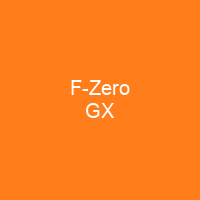F-Zero GX is a 2003 racing video game developed by Amusement Vision and published by Nintendo for the GameCube console. The game was the first significant video game collaboration between Nintendo and Sega and was released alongside GX in 2003. It is the successor to F- Zero X and continues the series’ difficult, high-speed racing style.
About F-Zero GX in brief

In the Grand Prix mode, the player races against twenty-nine opponents through three laps of each track in a cup. Players get a certain number of points for finishing a track depending on where they placed. The winner of the circuit is the character who receives the most total points. A heavy emphasis is placed on track memorization and reflexes, which aids in completing the game. Each machine handles differently, has its own performance abilities affected by its weight, and a grip, boost, and durability trait graded on an A to E scale. Each racing craft contains air brakes for navigating tight corners by using the control stick and shoulder buttons. Pit areas and dash plates are located at various points around the track for vehicles to drive over. The former replenishes energy, while the latter gives a speed boost without using up any energy. Courses may also have jump plates, which launch vehicles into the air enabling them to cut corners. Players can easily exploit this on a wide straight stretch of a circuit to generate serpentinous movements, but it is best used on the easier tracks, when racing alone in Time Trial, and with heavy vehicles with a high grip rating and given high acceleration. A predetermined number of players are chosen based on the difficulty level before starting a race. Competitors can be damaged and eliminated by means of a side attack or a spin spin. Players receive a password based on their position in the database.
You want to know more about F-Zero GX?
This page is based on the article F-Zero GX published in Wikipedia (as of Dec. 07, 2020) and was automatically summarized using artificial intelligence.







